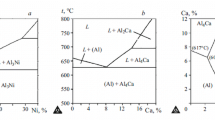Abstract
The influence of the modes of thermal-and-temporal treatment and cooling rate of metallic alloys on crystallization regularities of Al–Sc alloys and their structure, properties, and modifying ability are established. Castings of Al–Sc alloy, which were prepared by the electrolysis of salt melts KF–NaF–AlF3–Sc2O3 at 820–850°C, are used as the initial charge for casting. It is established that, by varying the magnitude of melt overheating and casting temperature, it is possible to vary the crystal shape, amount, and size in wide limits. The modifying action of cast and rapidly quenched master alloys, as well as the master alloy produced by electrolysis, is tested for Al–4.5% Cu alloy. The largest effect of milling the structure of the Al–4.5% Cu–0.4% Sc alloy is attained when using the rapidly quenched master alloy.
Similar content being viewed by others
References
Elagin, V.I., Zakharov, V.V., and Rostova, T.D., Prospects of alloying aluminum alloys with scandium, Tzvetn. Met., 1983, no. 12, pp. 96–99.
Elagin, V.I., Zakharov, V.V., and Filatov, Yu.A., Certain materials science principles of alloying, production technology, and heat treatment of aluminum alloys alloyed with scandium, Technol. Legk. Splav., 1989, no. 9, pp. 27–34.
Filatov, Yu.A., Deformable alloys based on the Al–Mg–Sc system, Metalloved. Term. Obrab. Met., 1996, no. 6, pp. 33–36.
Zakharov, V.V. and Rostova, T.D., High-strength weldable alloy 1970 based on the Al–Zn–Mg system, Metalloved. Term. Obrab. Met., 2005, no. 4, pp. 10–17.
Elagin V.I., Zakharov. V.V, Filatov Yu.A., Rostov T.D. Development of promising aluminum alloys alloyed with scandium, in: Perspektivnye tehnologii legkih i special’nyh splavov (Promising Technologies of Light and Special Alloys), Moscow: Fizmatlit, 2006, pp. 181–193.
Zakharov, V.V., Influence of scandium on the structure and properties of aluminum alloys, Metalloved. Term. Obrab. Met., 2003, no. 7, pp. 7–14.
Napalkov, V.I., Makhov, S.V., and Popov, D.A., Production of master alloys for aluminum alloys, Metalloved. Term. Obrab. Met., 2011, no. 10, pp. 18–24.
Brodova, I.G., Popel, P.S., Barbin, N.M., and Vatolin, N.A., Iskhodnye rasplavy kak osnova formirovaniya struktury i svoistv aluminievykh splavov (Initial Melts as the Basis for the Formation of the Structure and Properties of Aluminum Alloys), Ekaterinburg: Ural. Otd. Ross. Acad. Nauk, 2005.
Nikitin, V.I. and Nikitin, K.V., Nasledstvennost’ v litykh splavakh (Heredity in Cast Alloys), Moscow: Mashinostroenie-1, 2005.
Brodova, I.G., Polenz, I.V., Esin, V.O., and Lobov, E.M., Formation regularities of the cast structure of supercooled Al–Ti alloys, Fiz. Met. Metalloved., 1992, no. 1, pp. 84–89.
Brodova, I.G., Polenz, I.V., and Popel, P.S., Role of the structure of master alloys during the modification of aluminum alloys with zirconium, Fiz. Met. Metalloved., 1993, vol. 76, no. 5, pp. 123–131.
Golubev, S.V., Korzhavina, O.A., Popel, P.C., Kononenko, V.I., Brodova, I.G., Polenz, I.V., and Shubin, T.B., Influence of viscosity and electrical resistivity on the structural state of Al–Sc melts and structure of cast metal, Metally, 1991, no. 1, pp. 46–51.
Shtefanyuk, Yu., Mann, V., Pingin, V., Vinogradov, D., Zaikov, Yu., Tkacheva, O., Nikolaev, A., and Suzdaltsev, A., Production of Al–Sc alloy by electrolysis of cryolite-scandium oxide melts, Light Met., 2015, pp. 589–593.
Zakharov, V.V., Breakdown kinetics of the solid solution of scandium in aluminum in Al–Sc binary alloys, Metalloved. Term. Obrab. Met., 2015, no. 7, pp. 44–48.
Zakharov, V.V., Peculiarities of crystallization of aluminum alloys alloyed with scandium, Metalloved. Term. Obrab. Met., 2011, no. 9, pp. 12–18.
Author information
Authors and Affiliations
Corresponding author
Additional information
Original Russian Text © O.Yu. Tkacheva, I.G. Brodova, P.A. Arhipov, Yu.P. Zaikov, 2016, published in Izvestiya Vysshikh Uchebnykh Zavedenii, Tsvetnaya Metallurgiya, 2016, No. 6, pp. 55–64.
About this article
Cite this article
Tkacheva, O.Y., Brodova, I.G., Arhipov, P.A. et al. Influence of crystallization conditions on the structure and modifying ability of Al–Sc alloys. Russ. J. Non-ferrous Metals 58, 67–74 (2017). https://doi.org/10.3103/S1067821217010126
Received:
Accepted:
Published:
Issue Date:
DOI: https://doi.org/10.3103/S1067821217010126




